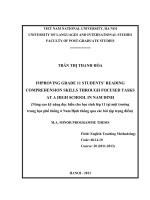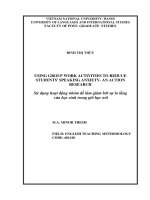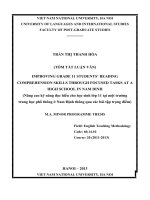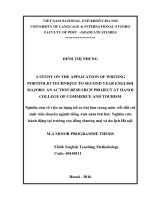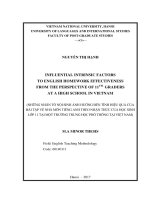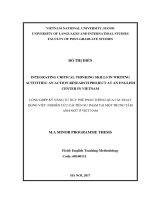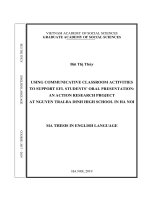Using pre reading activities to enhance students’ reading interests an action research project at a high school in ba vi district, ha noi
Bạn đang xem bản rút gọn của tài liệu. Xem và tải ngay bản đầy đủ của tài liệu tại đây (745.74 KB, 139 trang )
VIET NAM NATIONAL UNIVERSITY, HA NOI
UNIVERSITY OF LANGUAGES &
INTERNATIONAL STUDIES FACULTY OF POSTGRADUATE STUDIES *****************
TRẦN THỊ THU HẰNG
USING PRE-READING ACTIVITIES TO
ENHANCE STUDENTS’ READING
INTERESTS: AN ACTION RESEARCH
PROJECT AT A HIGH SCHOOL IN BA VI
DISTRICT, HA NOI.
(Sử dụng các hoạt động trước khi đọc để nâng cao hứng thú
đọc của học sinh: Một nghiên cứu hành động tại một trường
THPT của huyện Ba Vì, Hà Nội)
M.A MINOR THESIS
Field: English Teaching Methodology
Code: 8140231.01
Hanoi – 2020
VIETNAM NATIONAL UNIVERSITY, HANOI UNIVERSITY OF
LANGUAGES AND INTERNATIONAL STUDIES FACULTY OF
POST- GRADUATE STUDIES
TRẦN THỊ THU HẰNG
USING PRE-READING ACTIVITIES TO ENHANCE STUDENTS’
READING INTERESTS: AN ACTION RESEARCH PROJECT AT A
HIGH SCHOOL IN BA VI DISTRICT, HA NOI.
(Sử dụng các hoạt động trước khi đọc để nâng cao hứng thú đọc của học
sinh: Một nghiên cứu hành động tại một trường THPT của huyện Ba Vì,
Hà Nội)
M.A MINOR THESIS
Field
: English Teaching Methodology
Code
: 8140231.01
Supervisor : Dr. Vũ Thị Thanh Nhã
Hanoi – 2020
DECLARATION
I, Tran Thi Thu Hang, hereby certify that the thesis entitled “Using preth
reading activities to enhance students‟ interests in reading for the 10 form students
at a high school in Ba Vi district” is submitted for the partial fulfillment of the
Degree of Master of Arts at the Faculty of Post- Graduate Studies, University of
Languages and International Studies, Vietnam National University, Hanoi. I
also declare that this thesis is the result of my own research and efforts and it has
not been submitted for any other purposes.
i
ACKNOWLEGEMENTS
First and foremost, I would like to express my heart- felt thank and my
sincere gratitude to my supervisor Dr. Vu Thi Thanh Nha for her enlightening
guidance, precious suggestions and invaluable encouragement during my fulfillment
of this minor thesis.
My sincere thanks go to all of the lecturers and the staff of the Faculty of
Post- Graduate Studies at University of Languages and International Studies for the
valuable lectures on which my minor thesis was laid the foundation.
I truly wish to thank all the students of class 10A4 at Bat Bat High School
who have actively participated in the research.
I am deeply grateful to my family for their great support and to many of my
colleagues for their notable assistance.
ii
ABSTRACT
An important goal of language teaching is to awaken learners‟ interest in
language and also to give them a lasting positive attitude towards reading. The
primary purpose of this study is to examine on types of teachers‟ pre-reading
strategies to attract students‟ attention and interest towards learning reading lessons,
to investigate reasons why students tend to lose interest in reading lessons and to
examine the impact of using three pre-reading activities (games, visual aids and
group discussion) to enhance students‟ interests in learning. This study was carried
out among 41 grade ten students in a high school in Ba Vi district. Data were
collected through questionnaires, classroom observation and teaching diaries and
then the data were analyzed quantitatively and qualitatively. The results of the data
analysis indicate that students have relatively low interest in reading lessons due to
the lack of interesting pre-reading activities from the teacher. Some adjustments on
pre-reading activities have been executed and these activities have brought about
positive changes to language learning. The results show that three pre-reading
activities applied have considerable impacts on students‟ learning. Classroom
learning has been promoted and students‟ interactions have been strengthened. The
students made considerable progress in their reading lessons and they also actively
engaged in the lesson with high motivation. From these findings, it can be suggested
that teachers should take actions in developing and enhancing students‟ reading
interests.
iii
LISTS OF FIGURES AND TABLES
Figure 3.1: Cyclical
Mctaggart...........
Figure 4.1: Students‟ opinion about the reading lesson ..............................................................
Figure 4.2: The reasons why the students thought the reading lessons were not interesting .....
Figure 4.3: The frequency of pre-reading activities used by teacher in reading lessons ......
Figure 4.4: Students‟ opinions on pre-reading activities.............................................................
Table 4.1: Students‟ opinions about pre-reading activities.........................................................
Figure 4.5: Purposes of pre-reading activities ...............................................................................
Figure 4.6: Pre-reading activities offered by the students...........................................................
Table 4.2: Descriptive statistics of the students‟ attitude towards reading lesson. (Cycle 1) ............
Table 4.3: Students‟ opinion on using pictures and videos ........................................................
Table 4.4: Students‟ opinion on group discussion .......................................................................
Table 4.5: Descriptive statistics of the students‟ attitude towards reading lesson. (Cycle 2)................
Table 4.6: The students‟ opinion on game and group discussion .............................................
Table 4.7: Descriptive statistics of the students‟ attitude towards reading lesson.
(Cycle 3) ....................................................................................................................
iv
TABLE OF CONTENTS
DECLARATION
i
ACKNOWLEGEMENTS
ii
ABSTRACT
iii
LISTS OF FIGURES AND TABLES
iv
TABLE OF CONTENTS
v
CHAPTER 1. INTRODUCTION
1
1.1. Rationale for the research
1
1.2. Aims and objectives of the research
2
1.2.1. Aims of the research
2
1.2.2. Objectives of the research
2
1.3. Research questions
2
1.4. Scope of the research
3
1.5. Methods of the research
3
1.6. Significance of the research
3
1.7. Organisation of the thesis
3
CHAPTER 2. LITERATURE REVIEW
5
2.1. Theoretical background of reading
5
2.1.1. Definition of reading....................................................................................... 5
2.1.2. Classification of reading.................................................................................. 6
2.2. An overview of reading comprehension
7
2.2.1. Definition of reading comprehension............................................................... 7
2.2.2. Stages in a reading comprehension lesson...................................................... 8
2.3. Theoretical background of pre-reading activities
9
2.3.1. Definition of pre-reading activities.................................................................. 9
2.3.2. Pre-reading techniques.................................................................................. 10
2.4. An overview of interest
12
2.4.1. Definition of interest...................................................................................... 12
v
2.4.2. Types of interest............................................................................................. 13
2.4.3. The aspects of interest................................................................................... 14
2.4.4. Factors influencing interest........................................................................... 15
2.4.5. The importance of interest to learning........................................................... 17
2.5. Literature review of interests in reading
18
2.6. Relationships between pre-reading activities and interest
19
2.7. Previous studies on pre-reading stage and interest
20
2.8. Summary
23
CHAPTER 3. METHODOLOGY
24
3.1. Context of the study
24
3.1.1. The research site............................................................................................ 24
3.1.2. Materials....................................................................................................... 24
3.2. Participants....................................................................................................... 25
3.3. Research method: Action research
25
3.3.1. Definition of action research......................................................................... 25
3.3.2. Action research model................................................................................... 26
3.4. Data collection instruments
28
3.4.1. Questionnaire................................................................................................ 28
3.4.2. Teaching diary............................................................................................... 29
3.5. Data analysis procedures
30
3.6. Research procedure
31
3.7. Summary
34
CHAPTER 4. DATA ANALYSIS AND FINDINGS
35
4.1. Research cycle one
35
4.1.1. Analysis of classroom observation................................................................. 35
4.1.3. Analysis of the teaching diaries.................................................................... 45
4.1.2. Analysis of the questionnaires to the students………………………..……46
4.1.4. Data collected from post-questionnaires....................................................... 48
4.2. Research cycle two
54
4.2.1. The students’ attitude towards the reading lesson.........................................54
vi
4.2.2. The students’ opinions about games and group discussion............................ 55
4.3. Research cycle three
56
4.4.1. What are students’ opinions about reading lessons?.....................................58
4.4.2. How effective is the use of three pre-reading activities in enhancing students’
reading interest?...................................................................................................... 59
4.4.3. What are students’ attitudes towards these activities?...................................60
4.5. Summary
61
CHAPTER 5. CONCLUSION
63
5.1. Recapitulation
63
5.2. Concluding remarks
64
5.3. Implications
65
5.4. Limitations
66
5.5. Suggestions for further research
67
REFERENCES
68
APPENDIXES
I
vii
CHAPTER 1. INTRODUCTION
1.1. Rationale for the research
Interests in learning, especially in teaching and learning reading skills have
addressed the attention of many researchers. As we know that, interests have a
powerful impact on students‟ reading abilities. Kragler and Nolley (1996) claim that
determining children‟s interests can motivate children to read more difficult reading
materials. Wolfson and Manning (1984) found that students comprehend more when
they read materials of interest. For this reason, making reading an enjoyable activity
is very important, and to improve students‟ reading ability, the reading activities
used in teaching reading must also be enjoyable. It can be said that without interests,
someone is impossible to do anything. Therefore, it is important that teachers should
pay attention to students‟ interests to help them read at a higher level and
comprehend the text more successfully.
It is undeniable that pre-reading activities play an important role in the
success of teaching reading skill. According to Celce-Murcia (1991), pre-reading
activities not only activate the reader‟s prior relevant knowledge to the
understanding of the new text but they also provide language preparation and
motivate reading. An effective pre-reading activity makes the reading lesson more
enjoyable and less challenging. It is assumed that if the students are interested in
pre-reading state, their reading tasks will be more successfully completed and
obstacles in while-reading stage will become less.
As an English teacher for more than ten years, the researcher has realized the
significant effects of pre-reading activities on students‟ reading performance.
However, in the context of teaching and learning in a high school in Ba Vi district,
the author found that the use of pre-reading tasks has been far from satisfactory. In
most reading lessons, teachers seem to follow repeated tasks in textbooks without
any adaptation. Students, therefore, merely spend most of their time following what
the teacher asks with low emotion and cooperation. Sometimes, the teachers use a
1
lot of pre-reading activities in their reading lesson but not all of them take effect in
raising students‟ learning performance and interests. Some activities are thought to
be effective but in fact they do not always work well and sometimes demotivate
students‟ learning. Moreover, there are only a few studies that are deal with the
effects of pre-reading on raising students‟ interests in reading. These gaps are the
subject of research in this study. This study was carried out with a view to finding
out which pre-reading activities can help enhance students‟ interests in learning
reading skill as well as find out their attitudes towards these activities. Based on the
findings of this action research, some appropriate pre-reading strategies will be
applied as a useful tool to enhance students‟ interests in learning and to facilitate
their reading comprehension skill. Hopefully, the study would offer some practical
suggestions for teachers to design more effective pre-reading activities.
1.2. Aims and objectives of the research
1.2.1. Aims of the research
The study was carried out with an aim to find out effective pre-reading
activities to increase students‟ interests in reading to adjust teaching and learning
activities.
1.2.2. Objectives of the research
The objectives of the research were to find out whether the students in a high
school in Ba Vi district were interested in reading lessons or not, and to check the
effectiveness of three pre-reading activities (games, discussion and visual aids) in
enhancing students‟ reading interest. It also examined students‟ attitudes towards
these pre-reading activities and proposed some suggestions for teachers to foster
students‟ interests in learning.
1.3. Research questions
With the given aims and objectives, the study aimed to answer three research
questions:
1.
What are students’ opinions about reading lessons?
2.
How effective is the use of three pre-reading activities in enhancing
students’ reading interests?
3.
What are students’attitudes towards these activities?
2
1.4. Scope of the research
The study was conducted at a high school in Ba Vi District, Ha Noi. Because
of the limited time, it only focuses on using pre-reading activities to raise the
students‟ reading interests to grade 10 students, so the teaching of other skills or
other grades would be beyond the scope.
1.5. Methods of the research
The author used action research for the study and the data is collected by
using quantitative and qualitative techniques. In order to achieve reliable results for
the study, the author chose classroom action research in which survey
questionnaires for students, classroom observation and teaching diary were used to
collect data. The study was carried out during 12 weeks, and the research cycle
consisted of four phases: planning; action; observation and reflection.
1.6. Significance of the research
The research is designed with the hope to contribute effective ways to raise
students‟ reading interests by using different pre-reading activities. As a result, the
students will be expected to gain a higher level of English and to perform better in
their language learning in general, especially in reading comprehension in
particular. In terms of practice, the finding of this research can be used as a
reference for teachers of English in their own teaching.
1.7. Organisation of the thesis
The thesis consists of five chapters as follows:
Chapter 1: Introduction- This chapter presents the rationale for choosing
the field for studying, the aims and objectives, the scope of the study, the research
questions and the significance and the design of the research.
Chapter 2: Literature Review- This chapter deals with a review of
theoretical issues related to the definition of reading, reading comprehension, prereading techniques, interest, the relation between pre-reading activities and interest
as well as previous studies related to the problem under investigation.
Chapter 3: Methodology- This chapter mentions the methods and procedure
3
of the study and includes background information of the context where the study is
conducted, the subjects, the instruments used to collect the data and the procedure
of data collection.
Chapter 4: Findings- This chapter aims at describing the analysis of data in
detail and giving the summary and discussion of the findings.
Chapter 5: Conclusion- This part offers a summary of the findings,
recommendations, limitations as well as suggestions for further study.
4
CHAPTER 2. LITERATURE REVIEW
Chapter 2 presents the basic theories related to reading, pre-reading strategies
and interests in reading, a brief review of the importance of interest in learning and
the relation between pre-reading activities and interest.
2.1. Theoretical background of reading
2.1.1. Definition of reading
Reading is a natural and common activity that people often do in their daily
life. Among the many definitions of reading, Anderson (1985, p.19) defines reading
as a process in which information from the text and the knowledge owned by the
readers act together to create meaning. From his viewpoint, the readers‟ background
knowledge of the reading text is very important to their reading success. Sharing
with Anderson‟s viewpoint, Krashen (1989) claimed that the reader interacts with
the written texts through different cognitive processes such as negotiating the
meaning of the texts, using prior background knowledge, processing lexical items
and many other reading strategies. Whereas Phakiti (2006) said that reading
involves interactions among the reader‟s interlanguage competence, personal
characteristics and external contexts. According to Richards et al (1985), reading is
the perception of a written text in order to understand its contents. Two major
mental operations are crucial in this definition: perception and understanding. The
former aims at recognizing words, phrases, sentences, paragraphs and/or the whole
text; whereas the latter focuses on the comprehension of the meaning conveyed.
During the reading process, readers repetitively form their own hypotheses and
predictions and use their prior knowledge of language to construct meaning.
Although the reasons for reading may vary, the primary purpose of reading is
understanding or attaining information from the text. Reading is considered as a
thinking process because it allows the reader to use what he or she may already
know, also called prior knowledge. During this processing of information, the reader
uses different strategies to understand what they are reading, using themes to
organize ideas, and using textual clues to find the meanings of new words.
5
In summary, the definition of reading may vary among different researchers.
However, most of these show some common characteristics of reading, that is the
close relation between the context of the reading text and the readers‟ background
knowledge. When individuals have chances to activate their background knowledge
and the understanding of the context, they will obtain more information and their
knowledge will be widened. It can be concluded that reading is a very complex
activity that demands of its readers much care and knowledge, skills and strategies
to do it successfully.
2.1.2. Classification of reading
2.1.2.1. Classification of reading according to manner
Reading can be classified by two criteria (manner or purpose). By manner,
there are two types of reading, reading aloud and silent reading. According to Doff
(1988, p.70) “Reading aloud involves looking at the text, understanding it and also
saying it.”. Its purpose is not just to understand a text but also to convey the
information to someone else. When reading aloud, students focus on pronunciation,
spelling sounds but not on meaning, so reading skill is not much improved. Unlike
reading aloud, silent reading is often used in real life and classroom. Silent reading
is a reading skill which allows one to read without voicing the words. It is an
activity focusing on the meaning of the text. This type of reading is useful for
development of reading skill in class.
2.1.2.2. Classification of reading according to purposes
By purposes, reading is categorized into skimming, scanning, intensive and
extensive reading. Skimming is reading rapidly in order to have a general overview
of the material. Skimming allows readers to pick up some of the main ideas without
paying attention to detail. According to Grellet (1981, p.19), “when skimming, we
go through the reading materials quickly in order to get its main points or the
intentions of the writer, but not to find the answer to specific questions”, whereas
scanning is defined as reading rapidly to find specific information. Nuttall (2000,
p.49) indicated that “scanning means glancing rapidly through a text either to search
6
for a specific piece of information or to get an initial impression of whether the text
is suitable for a given purpose.”.
Extensive reading involves rapid reading of large quantities of material or
longer readings for general understanding. According to Elley (1991), extensive
reading aids learners to focus more on meaning rather than on form and extensive
reading involves extensive input of meaningful prints. In this type of reading,
students are free to choose the content area of reading and reading purposes focus
on pleasure, information and general understanding. The last classification is
intensive reading. Grellet (1981, p.41) defined “intensive reading means reading
short texts to extract specific information.” According to Brown (2007), intensive
reading is "a classroom-oriented activity in which students focus on the linguistic or
semantic detail, grammatical forms, discourse markers, and other surface structure
details for the purpose of understanding”. In intensive reading, students can improve
their English vocabulary skills. It can be concluded that reading in the classroom is
mainly intensive reading.
In short, reading can be categorized into different types depending on its
manner and purposes. Understanding clearly about different types of reading can
help teachers offer flexible adjustments to make their teaching and learning more
effective and meaningful. The following section will analyse features related to
reading comprehension.
2.2. An overview of reading comprehension
2.2.1. Definition of reading comprehension
Reading comprehension is a significant skill that furthers the development of
learners‟ various academic tasks. Pressley (2000) defined reading comprehension as
the ability to get meaning from what is read. Sharing his viewpoints, Hermosa
(2002) stated that reading comprehension is a series of cognitive activities that
include various dimensions like the understanding of words and their meanings,
mindful reaction, and integration. Pardo (2004, p.272) stages that comprehension is
a “process on which readers construct meaning by interacting with text through the
combination of prior knowledge and previous experience, information in the text,
7
and the stance the reader takes in relationship to the text”. Meniado (2016)
considers that reading comprehension is a complex process that involves
components, processes, and factors with the aim of finding better ways of
improving it among learners. He added that reading comprehension is an interactive
process of finding meanings from a text. Koda (2007) focused on various variables
that impact learners‟ reading comprehension such as vocabulary knowledge, prior
knowledge, metacognitive information, and reading strategies. While Trehearne and
Doctorow (2005) considered that learners‟ reading attitudes, useful teaching on
comprehension methods, versatility, text form, and being aware of various reading
comprehension strategies are factors that directly affect reading comprehension.
From the above definitions, reading comprehension can be defined as a
complicated process in which the learners use their background knowledge to
extract, analyze and understand the information transmitted through written words.
There are various factors that impact learners‟ reading comprehension such as the
complexity of the text, the environmental condition, the anxiety of learners during
the reading comprehension process, the interest and motivation or the medical
problems. To assist learners in understanding the text easily and become successful
readers, teachers should help learners develop their background knowledge, provide
learners with appropriate and effective reading comprehension strategies. And more
importantly, teachers should encourage and strengthen learners‟ interests and
motivation to read.
2.2.2. Stages in a reading comprehension lesson
Teaching a reading lesson requires that you are familiar with the framework
used to teach a reading lesson. A reading lesson is made up of activities to activate
student‟s background knowledge, present new vocabulary and tasks while students
read the passage and after the reading is over. According to William (1984), a
reading lesson is often divided into three stages. They are pre-reading stage, whilereading stage and post-reading stage. He adds that each stage carries its own
features and requires different techniques and strategies. Pre-reading activities are
those that help students think about what they know about a topic and predict what
they will read or hear. The purpose of pre-reading activities is to establish a purpose
8
for reading, to improve vocabulary and to create favorable learning environment so
students can complete all the reading tasks successfully. While-reading activities are
defined as tasks that help students to focus on aspects of the text and to understand
it better, the goal of these activities is to help learners to deal with the text. Some
activities in this stage are identifying the topic sentences and the main idea of
paragraphs, distinguishing between general and specific ideas. Post-reading stage is
the last stage in teaching reading. Post-reading activities help students understand
texts, through critically analyzing what they have read. William (1984) pointed out
that the post-reading stage is aimed at consolidating and reflecting what has been
read. For this reason, its main purpose is to ensure learner‟s comprehension of the
information of the text that they have already read. It is also to help learners
remember what they have created in their mind about the text.
2.3. Theoretical background of pre-reading activities
2.3.1. Definition of pre-reading activities
Pre-reading activities mean tasks or activities that students do before they
read the text in detail. The purpose of this stage is to facilitate while-reading
activities. These activities have been considered as effective learning tools to help
readers better comprehend reading texts and to avoid possible failure in
understanding information during the reading process. Pre-reading activities provide
learners with “cultural background, stimulate students‟ interest in the text, and preteach vocabulary” (Laza, 1993, p. 83). Meanwhile, Wasik and Bond (2001),
Pemberton and Road (2009) described pre-reading activities as series of activities
like games, play, jigsaw puzzles, role playing and imitation to which pupils are
exposed. Tudor (1989) called pre-reading activities “enabling” ones because they
provide readers with the necessary background to organize activites and to
comprehend the material. Celce-Murcia (1991) said that the goals of pre-reading
stage are to activate the students‟ knowledge of the subject, to provide any language
preparation that might be needed for coping with the passage and, finally to
motivate the learners to read the text. According to Langer (1981) and Johnson
(1982), pre-reading activities prepare readers for the upcoming concepts and make
9
the reading tasks easier. Ringler and Weber (1984) shared the ideas and added that
pre-reading activities elicit prior knowledge, build background, and focus attention.
In sum, in pre-reading stage, the students and teacher prepare themselves for
the tasks and familiarize themselves with the topic of the reading exercises. The
purposes of pre-reading activities are to activate students‟ prior knowledge, prepare
students for linguistic difficulties in a text and to motivate them to learn. Prereading activities are used as a good way to remind the readers of their previous
knowledge and to build necessary knowledge needed for dealing with the content
and the structure of the materials. It is important for teachers to recognize that these
activities should be more focused to help their students more engage in reading and
create interests in learning.
2.3.2. Pre-reading techniques
According to Vygotsky (1978), learning happens when students are
interacting cooperatively with their peers in their own environment. Therefore,
teachers should take different communicative activities in class to help students
engage in learning. Various techniques of pre-reading stage have been suggested to
engage students and enhance their interests in reading. Carrell (1983) suggested
some ways to build and activate learners‟ schema in pre-reading stage such as
viewing movies, slides, pictures, debate or class discussions, demonstrations or roleplay activities. Zhao and Zho (2012) suggested some activities like questions,
brainstorming, pre-teaching, pre-texting and pre-discussing. All of them are
considered warm-up activities that can help involve learners into the reading
process, arouse their interest and curiosity and activate their schema. Among these
pre-reading activities, group discussion, visual aids and games were chosen as
treatments in the research because they may be suitable with the teaching context
and because of their promising roles in enhancing students‟ interests in reading.
Games in Language Learning. Musa (2012) discussed that games are
activities that are in great harmony to the mind and provide learners the
environment to compete while maintaining their enthusiasm. Ghamrawi (2014) adds
that games stimulate children to be more active participants in classroom activities.
10
Games have a great educational value and it can be used in the classroom to
encourage learners to interact, to cooperate, to be creative and spontaneous in using
the language in a meaningful way. It can be said that using games at pre-reading
stage is regarded as an effective way in raising students‟ interest in learning. Chen
(2005) stated in his journal that the benefits of using games in language learning are
promoting communicative competence, creating a meaningful context for language
use, increasing learning motivation, reducing learning anxiety, encouraging creative
and spontaneous use of language and constructing a cooperative learning
environment. Several useful games are suggested for introducing the text, namely,
lucky number, crossword, guessing games, and word games.
Visual aids: There are a number of benefits in using visual aids in prereading stage. Firstly, according to Bowen (1982) and Bellver (1989), using visual
aids in reading creates strong engagement between students and the texts. The use
of visual aids like pictures, videos and projectors encourages students to read the
texts with high level of interest, which makes it easier for students to understand
different abstract ideas. In a study conducted by Sivapalan, Ahmad and Ishak
(2009), pictures could help students to understand different meanings and the
messages of the text better. In language learning, learners often encounter
difficulties understanding the concepts of the texts. To solve this learning problem,
visual aids such as graphics, illustrations, pictures, audio, and video can be used as a
helpful tool in facilitating students‟ understanding of different concepts that occur
in the texts. It can be concluded that the characteristics of the visual aids like sound,
light and color can trigger and stimulate students‟ understanding of the texts.
Group discussion: This activity has been considered as a useful way to
activate what students know, to exchange the information and to enhance the
students‟ knowledge of the subject. According to Goldenberg (1991), discussions
help learners produce opinions and new questions. Discussion can be done by
posing questions about the contents of the texts. Nuttal (1982) claimed that
discussion promotes the active struggle with the text and students have more
chances to promote their critical thinking. Group work is ideal because in small
11
groups, a participant has chances to put across his/her viewpoint, the weaker
students would share their opinions with stronger ones to be active and get involved.
Group discussion works on learner-centered so it gives opportunities to all members
to express their ideas and opinion on a certain topic. Moreover, it increases
students‟ confidence in speaking and helps them enhance their ability to articulate
and defend a position thoughtfully and respectfully.
Overall, various studies of pre-reading activities concerning definition, types,
techniques have been discussed. However, the review of literature shows that little
research focuses on the effects of each pre-reading activity in enhancing students‟
interest in reading. The effects of pre-reading activities in enhancing students‟
interest, the students attitudes towards these activities are not explained thoroughly,
so the teacher lacks practical support to make full use of these. Sometimes, teachers
use alot of pre-reading activities in class but not all of them could enhance students‟
interest. The gaps are the subject of this research. The following section will analyse
features related to interest.
2.4. An overview of interest
This section analyses key features of interest, definition, types, aspects,
factors influencing interest and the important of interest to learning.
2.4.1. Definition of interest
Interest has been viewed differently among researchers. Basically, interest
refers to the inner tendency of an individual. Dewey (1913) once described interest
as being engaged, or entirely taken up with an activity, object, or topic. Pintrich
(1989) and Schiefele (1991) defined interest as a positive feeling about the topics,
subjects and activities. From this point of view, interest could be expressed with
happines when students do something or some learning activities. Hidi and
Renninger (2006) described interest as a unique motivational variable and as a
psychological state that occurs during interaction between individuals and objects or
activity that they interest. This interaction includes a process of willingness to
engage in a specific object or activity. Aksan and Kisac (2009), Guthrie (2007)
12
shared the same opinion that interest is regarded as a positive feeling of individual
including engagement, attention, concentration, happiness and willingness to spend
more time to do activity. Hidi and Baird (1986); Schiefele (1999) Renninger (2000)
believed that interest plays an essential role in learning and they stressed that
students could find it difficult to follow the reading activities when they do not have
interest.
Based on the explanations above, interest can be concluded as a positive
feeling of a person including engagement, attention, happiness and willingness to
spend more time on something. To learning, interest has a great impact on students‟
learning and performance. It plays an important part in the learning process since it
promotes active engagement and focuses one‟s attention. Students have a tendency
not to learn well when they are not interested in learning activities. So when
students are interested in learning, they will show appropriate behaviors such as
attention, activeness and engagement in all activities that support learning.
2.4.2. Types of interest
Interest is not innate or natural, it grows based on individual ages and
experiences. Krapp (2002) believed that interest grows and developes based on the
relationship between individual purpose and environment factors. According to him,
interest is commonly categorized as situational interest and individual interest.
Situational interest is an emotional state aroused by features of environmental or
textual stimuli. It is fostered by the condition of environmental factors, and it is a
response to certain conditions or stimuli in the learning environment so it may last
for a long time. Hidi (1990), Hidi and Renninger (1992), Schiefele (1999) shared
the viewpoint that individual interest is considered to be a stable and enduring
inclination to engage with activities or objects. It refers to individual characteristics.
It involves knowledge, positive affect and value. Interest starts from stimulus in the
environment (situational interest), and individual interest is formed from situational
interest. Kintsch (1980) clarified the relationship between interest and learning. He
distinguished between two types of situational interest he referred to as emotional
and cognitive interest. Both types of interest support and influence learning
13
activities and learning performance of the students because when students have
interest to a specific topic, object or activity, they will create the strategies and
engage themselves in those tasks. Therefore, it is important to prepare students for a
good learning environment so that they will have chances to get involved in the
activities they are interested in.
2.4.3. The aspects of interest
Interest grows and develops based on the relationship between individual
purposes and environmental factors. Therefore, it is important to create purpose for
reading and prepare a good learning environment so that the students will be
involved, enjoy and tend to possess a knowledge base on the topic, object or activity
that they are interested in. Furthermore, Krapp (2002) and Hidi (2006) stated that
there are two aspects that contribute to develop interest, they are cognitive and
affective aspects
2.4.3.1. Cognitive aspect
Cognitive aspect refers to personal values and goals. It is related to anything
that can be beneficial and lead to personal satisfaction. It means interest in cognitive
aspects is grown and affected by the values and goals of the topic, object or activity.
When students are satisfied with the topic, object or activity, their interest can grow
stronger. Conversely, if there is no satisfaction and profit in their topic, object or
activity, interest could be weakened, or even disappeared (Hidi, 2006; Krapp, 2002).
2.4.3.2. Affective aspect
Affective aspect refers to feeling related to the experience (Hidi, 2006;
Krapp, 2002). This aspect emphasizes on feelings, personal experiences and
attitudes towards people who can influence others, such as parents, teachers, and
friends. This affective aspect has a greater role in developing interests. For example,
students who have good relationships with those who are in the habit of reading
perhaps will follow and engage themselves to do reading activity. Therefore,
students who have a strong interest in reading can spend more time in reading
activity. Meanwhile, students who lack interest will try to avoid reading activity.
14
The concept of reading interest emphasizes mental readiness, willingness and also
refers to beliefs and perception of individuals to engage in reading activity. It can be
concluded that affective aspect can influence individuals to engage in specific
activity. Renninger (2000) gave three factors that contributed to the development of
interest. They are knowledge, positive emotion and personal values. The next
section will focus on the factors influencing interest.
2.4.4. Factors influencing interest
Dewey (1913) made two basic assumptions about interest. First, according to
him, to satisfy students‟ intellectual and personal needs, interest must be present in
the classroom. Second, interest could be fostered by providing students with a
variety of materials and educational opportunities that promoted challenge and
autonomy. It can be said that interest is related positively to attention and learning.
It varies from person to person, and it is elicited by a variety of factors such as prior
knowledge, unexpected text content, text structure, and reader goals. Alexander and
Jetton (1996) focused on prior knowledge. Hidi (1990) mentioned unexpectedness
of information, Garner (1992) mentioned concreteness and vividness.
When mentioning the effects of classroom factors to situational interest. Deci
(1992) has suggested that classrooms that promote student autonomy and choice
increase intrinsic motivation and situational interest. Another factor influencing
interest is the aspect of the text or task with which students are engaged. Schraw
(1995) claimed that well-written texts and more interesting texts increase learning.
Students‟ prior knowledge also affects interest. Kintsch (1980) proposed that
moderate amounts of knowledge increase interest and learning, whereas high or low
prior knowledge may decrease it.
It can be concluded that interest plays an important role in learning and it is
important to enhance interest to increase students‟ engagement and learning.
2.4.4.1. Interest and students’ personality
In general, we can see an association between personality attributes and the
successful acquisition of a second language. During the learning process, students
15


